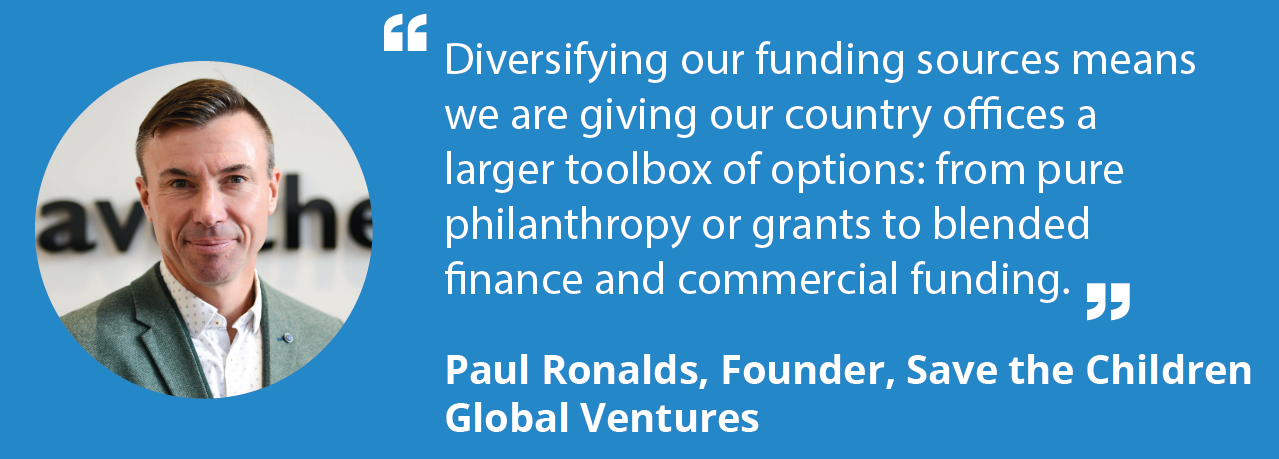Save the Children is one of the largest International Non-Governmental Organization (INGOs). It employs around 25,000 people across 117 countries and is focused on the health, education, and protection of children worldwide. While Save the Children had a number of innovative finance initiatives operating across its offices for many years, these were mostly small-scale and disconnected. In 2022, they launched Save the Children Global Ventures (Global Ventures), a Swiss-based foundation, to grow their innovative finance activities and take their use of new technologies to scale.
Save the Children’s technical expertise in health, education, and child protection as well as its established global networks, are leveraged by Global Ventures to guide and inform its investment decisions. They are currently in the process of launching a range of different products, with a focus on results-based finance, impact funds, and climate financing.
We spoke to Paul Ronalds, former CEO of Save the Children Australia and founder of Global Ventures, about what they're hoping to achieve with Global Ventures, how they measure impact, the challenges and opportunities they faced as an INGO breaking into the innovative finance/blended finance space, and much more.
Can you tell us a bit about how Save the Children and Global Ventures engages or plans to engage in blended finance?
After a number of years of investing directly into various social enterprises, in 2019 Save the Children launched our first child-focused impact investment fund, based in Australia. The fund was capitalized with a significant investment from Save the Children itself, and ultimately went on to attract investments from QBE, the global insurance giant, and a range of other private investors, including donor advised funds. Since then, we’ve deployed 60% of the AUD 7.5 million raised into mostly technology-oriented start-ups aligned with Save the Children’s missions.
Through Global Ventures, we are now developing a ‘family’ of impact funds. In November 2022, we launched the Children’s Impact Multiplier Fund. The multiplier fund is intended to fill the gap between the commercial funds and pure philanthropy. We have raised about USD 2 million in seed funding and are targeting at least USD 10 million within three years. Because this is an open-ended fund and the capital has been sourced through donations, it is much more flexible than the commercial fund. For example, for our results- based finance initiatives, if we need working capital, the Multiplier Fund could provide first-loss capital that would then allow us to ‘crowd-in’ private sector capital from investors that may have a lower risk appetite.
We are also hoping to raise a second, larger Australian-based commercial fund in April 2023 and a European-based commercial fund in late 2023.
As an INGO, can you tell us how it was getting these funds set up and approaching investors with your investment thesis? What challenges have you faced?
It was difficult. The first challenge we faced was a degree of skepticism that Save the Children could operate a successful impact investment fund. The second challenge was that some of Australia’s most established philanthropic institutions, who we approached and who were initially very enthusiastic about the fund, have completely separate grant making and investment activities. They inhabited different worlds. So many of these institutions were happy to make six-figure grants to Save the Children but we could not convince their investment committees to make even a five-figure investment in our investment fund.
Also, at least in Australia, there are very few truly impact-first investors. I can remember talking to one impact investor who essentially said we expect the same commercial returns as any other venture capital fund, but we want all of the deep social and environmental impact on top. These investors didn’t seem to appreciate that generating deep impact and doing robust impact measurement costs significant money and effort. In comparison, after fundraising in Europe, I have engaged with many more investors who appreciate the work that goes into generating deep impact and they are more open to conversations about slightly higher fees on the funds or some sort of modest trade off in relation to returns.
Do you have any advice for other INGOs that might want to go into this space?
They should start small and adopt a long-term strategy. Rather that raising your own impact fund, start by identifying investments, perhaps from internal initiatives, that you can make directly from your own balance sheet. From there you can build out your impact investing ‘muscle’ and develop an impact investing record.
Don’t underestimate the capacity building that needs to happen in your own organization. The Global Ventures team spends a lot of time working with our country offices to help them think through what aspects of their operations could be financed through blended finance or an impact investment. Developing a sustainable business model, thinking through market-fit, competitive advantage, and pitching investment ideas are not traditional NGO skill sets. As a result, it has taken some time to build a solid pipeline of investable opportunities from our country offices.
You need to bring specialist skills into the organizations to complement your natural strengths. You need to ensure that you bring your organizational leadership, especially boards, on the journey.
However, given the strategic challenges NGOs face, it’s critical that more NGOs consider how they can become more involved in blended finance, impact investing, and climate finance – these new ways of funding and supporting our missions. There is a USD 2.5 trillion annual funding gap to achieve the SDGs, and business as usual isn't going to be enough.
How do you measure the impact of your blended and innovative finance activities?
We are seeing increasing concerns globally about impact-washing. We share those concerns. Generally speaking, impact measurement is nowhere near as robust as it should be. As a result, we see robust impact measurement and management as a key competitive advantage for our innovative finance activities. We are seeking to bring Save the Children’s extensive global expertise around monitoring and evaluation together with the best international standards and frameworks to develop a comprehensive impact measurement and management approach.
How Global Ventures measures and manages impact depends on which product we're talking about. For our results-based finance work, we were very focused about identifying those interventions that satisfied some key criteria: Is it aligned with Save the Children’s mission? Is it something that Save the Children has significant experience in when it comes to implementation? Does it have a really robust evidence-base for every metric we're looking at? Are the metrics for measurement clear and generally undisputed? Then finally, does it offer real value for money? We only want to scale those interventions that make our dollars go as far as possible.
With our blended finance/impact funds, we use the SDGs as the way to characterize our impact; use the IMP's five dimensions as a starting point but added our own dimensions around serving underserved populations and ensuring additionality (“What’s the added contribution that Save the Children has?”); and also use the Operating Principles For Impact Measurement. So, we use a mix of well-accepted industry standards and frameworks that we then complement with a child-focused investing lens.
Using the SDGs is really helpful because it allows Global Ventures to consolidate its impact across multiple initiatives and products to understand what the organizational impact is across each of those SDG areas.
How do you see Global Ventures' blended finance activities evolving in the future?
I'm excited about our current momentum. By the end of this year, we expect to have a family of impact funds that can be used to meet different capital needs. From a Save the Children perspective, diversifying our funding sources means we are giving our country offices a larger toolbox of options: from pure philanthropy or grants to blended finance and commercial funding.
I'm also hopeful that the work we are doing will inspire other NGOs, particularly other large INGOs, to follow our lead and see innovative finance, blended finance, impact investment funds, as important complements to traditional funding sources. We really want to bring in other partners and players and help grow the innovative finance market.

